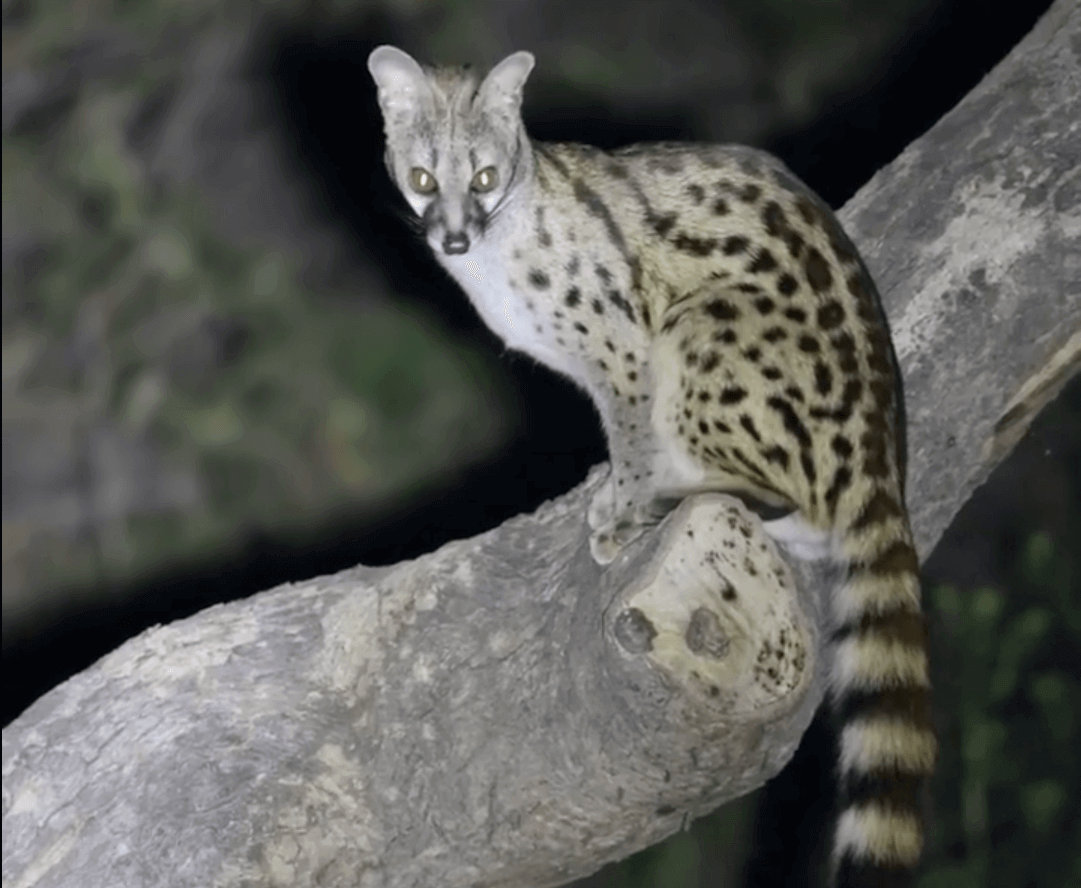Say African cats and you’ll typically create mental images of lions, leopards, and cheetahs prowling the savanna or bushveld under the blazing sun. But what about their smaller family members? Hunting in South Africa offers hunters an alternative to the big kitties by offering up small cats that can still deliver on the game hunting experience and trophy status.
Globally there are around 33 species of small wild cats, and South African hunting safaris offer a fair share of the good ones.
[DYNAMIC-BLOGTABLEOFCONTENT]
Key Takeaways
- Hunting safaris in South Africa are not only restricted to traditional options large or plains game.
- Small African cats can offer hunters an exciting and welcome change from other hunting species.
- Small cats can be hunted on a targeted or individual hunt, or as an accessory species to the main safari when hunting in South Africa.
- The number of small cat species globally is much higher than people realize, and South Africa is home to a fair share.
Small African cats and where to find them in SA
Like other game hunting species, these compact cats can be found in different provinces depending on the landscape and environment. The species discussed below are popular choices for both their hunting adventure and as accessory targets on other outings when hunting in South Africa.
Southern Caracal: South Africa’s Red Cat
Nicknamed the poor man’s leopard, the caracal has footholds across South Africa, Namibia, Zimbabwe, and across areas of the Middle East and Central Asian regions. The Southern Caracal, native to southern Africa, can be found in provinces like Limpopo, Free State, North West, Northern Cape, and the Eastern Cape.
A card-carrying member of the African cats family; the caracal is a medium-sized cat with males having a body length from 30–44+ inches and an average mass range of 15–40 pounds depending on maturity. Females are smaller and measure around 23–40 inches in length with a weight of between 15–35 pounds.
A main physical marker of the Caracal is the prominent ear tufts which measure around 2 inches in length and a coat that varies from reddish to sandy-hued in color. Their coat is short, coarse in texture, and dense, becoming even thicker in the cooler winter months. Their legs are long, with the back legs slightly longer, giving the caracal a sloping appearance from rump to head. Like the leopard, caracal are solitary animals and can be very vocal, using hisses, purring, and even a barking sound to communicate. Caracal are most active when hunting at night and prey on snakes, birds, young antelope, and other small mammals like rodents or farm stock.
When lining up your shot, the heart and lungs are the largest and primary targets, with the heart being behind the foreleg and lungs along the midway line. When facing the Caracal head-on, a shot to the middle of the chest can serve as a good target point.
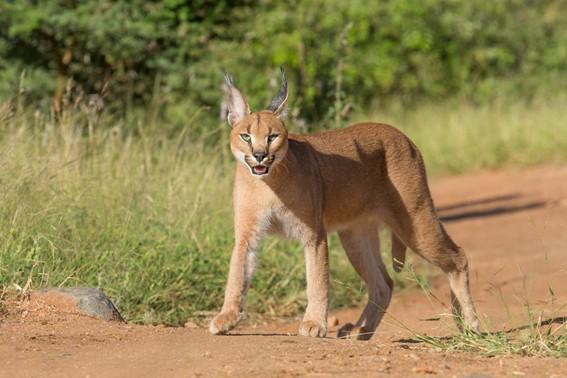
The Serval: sleek and solitary
This is another medium-sized wildcat of sub-Saharan Africa, with serval hunting in South Africa generally found in the Kwa-Zulu Natal, Limpopo, and Mpumalanga provinces of South Africa. Here they find residence in areas close to water and savanna grounds that provide cover and camouflage, useful for hunting and sheltering from the heat and predators. Males and females aren’t too different in size, ranging between 20–40 pounds and averaging 20–24 inches at the shoulder.
Like caracal, the serval targets rodents, birds, small reptiles, and even juvenile antelope. Living a life in solitary style, the serval isn’t partial to sharing spaces with their counterparts and can have “cat fights” over territory disputes. The Serval is mostly active at night when temperatures are lower and prey animals come out to forage, but they can be found during daylight hours.
Serval shot placement is very similar to other small cats, targeting the heart or lungs and even the head depending on the angle and hunter’s ability. Serval game hunting trips often take place at night, and a good scope, and patience, are recommended. Serval have great hearing, and can easily sprint off in large leaps or shoot up trees as an escape route.
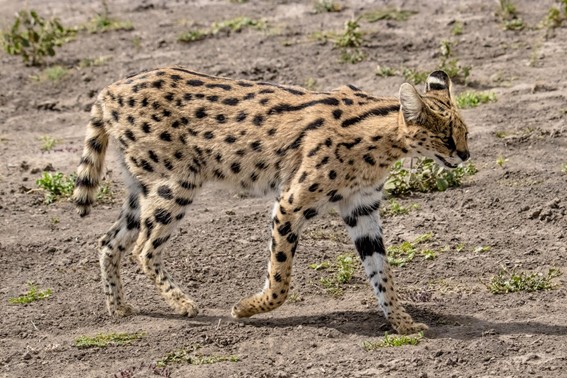
African wildcat: It’s not about the size of the Cat
Very closely related to the domestic cat; African wildcats are some of the smallest of the official African cats and can easily be overlooked, both literally and figuratively. They can be found across a variety of landscapes like grassland, fynbos, forest ranges, and even semi-arid areas. African wildcat hunting in South Africa is mostly found in the Limpopo, North West, and Northern Cape provinces.
Sandy grey in color with a yellow or reddish hue in its markings and a pale underbelly, the African wildcat has a broad stripe along the back and stripes on the side that fade in spots that help to conceal itself in the vegetation. Male African wildcats generally measure 18–24 inches in body length with females being shorter, coming in around 16–22 inches. Males have a longer tail than females and both genders weigh between 7 and 9 pounds.
Like other felines, these pocket-sized wildcats are very active at night and track their prey through highly attuned hearing and vision. They crawl and stalk through vegetation until the prey is within striking distance, the usual suspects of their prey include insects, rats, mice, birds, juvenile farm stock like lambs or chickens, as well as small reptilian species like lizards and snakes. When it comes to their predators, African wildcats are preyed upon by hyenas, other cats, and birds of prey like owls and hawks.
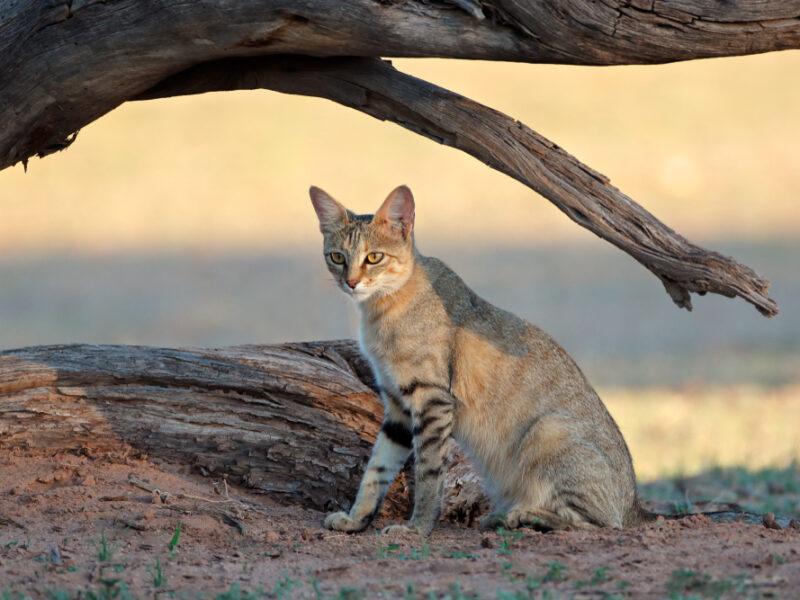
Cats by any other Name…
Small cat hunting in South Africa is commonly advertised and supplied as a combination hunt including more than one species of small African cats. Because of this, the below two offerings, although not technically cats, are regularly included in the package.
South African hunting safaris can offer the “weird and wonderful” species that hunters might not get to take on anywhere else in the world. So, if the occasion arises for these additional animals, don’t knock them till you try them…
Civet Cat
Unlike genets, Civet Cats are not actually related to cats at all. However, due to their appearance and behavior, they are often classed as “feline–like” and are often included in packages for small cat hunting in South Africa.
Civets are cat-like in certain features with an extended muzzle, while on the whole many agree the civet looks a relative of the raccoon. They have short and very dense grey fur with rows of black spots while their legs and tail are around 2/3 black with the tail having striping at the base. Black markings around the eyes give the Civet cat a real raccoon-like look. Males and females typically measure 17–28 inches in length, excluding the tail, and clock in at around 2–10 pounds depending on age and gender.
When it comes to their hunting regions, look to Limpopo and Mpumalanga’s Lowveld region where readily available water and sources of shade or cover during the daytime accommodate the civet very well. Like other small African cats, the civet employs nocturnal hunting for frogs, crabs (if available), rodents, insects, and birds. They’re not afraid of digging into carrion from time to time either, whether by force of desperation, or it simply being available.
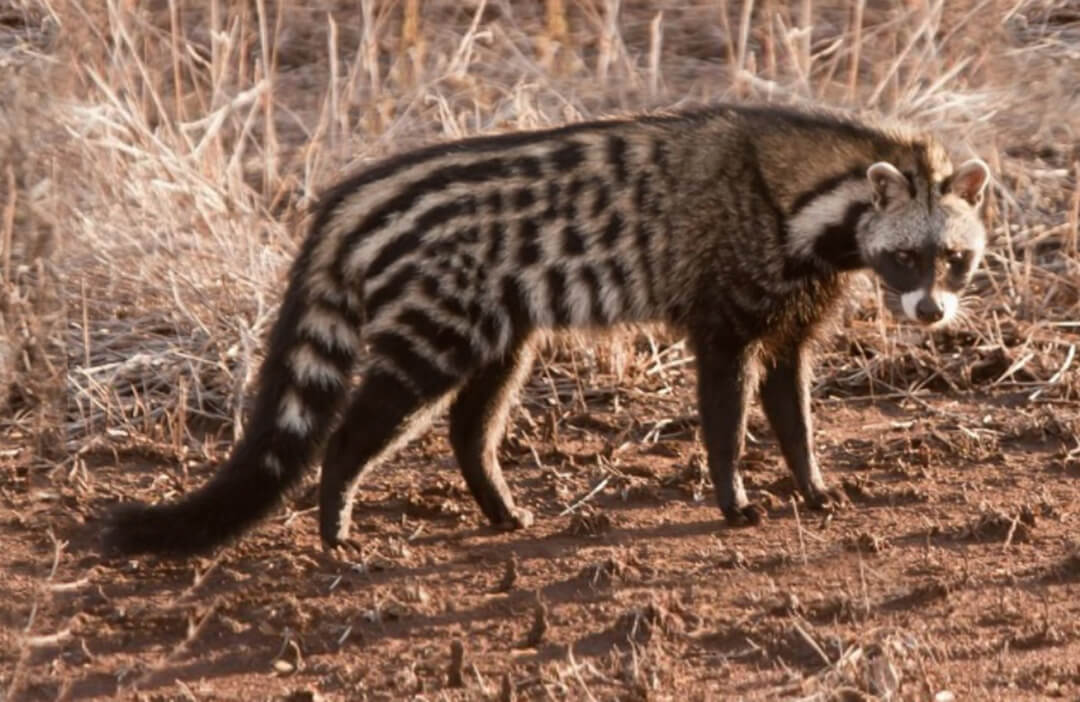
Genet
While the genet is related to the cat family, it is a closer relative to mongooses. Two varieties of this “anomaly” exist in South Africa. The small-spotted or common genet is found across Africa and in the South African game hunting territories of the North West, Limpopo, Mpumalanga, and Free State provinces. The large-spotted genet, aka Cape genet, is found only in South Africa in the regions of Limpopo and Kwa-Zulu Natal, as well as Western and Eastern Cape. Within the South African borders, the Common genet prefers savanna-type areas, as well as grassland and “vlei” type environments; the Cape genet adheres to the forests and fynbos regions of the coastal provinces it inhabits.
Genets are the only members of the Viverride family to be able to stand on their hind legs. They are extremely quick and athletic animals with great climbing skills, owing to their time spent in the trees. All genets sport a long ringed tail, pointed snout, large ears, and a long body featuring a stripe down the spine. Cape genets are ash grey, with brown markings and irregular spotting, while the Common genet is a darker grey with black markings. A distinguishing physical factor is that while Common genets have a white tail tip, the Cape genet does not.
Genet are largely nocturnal and prey on rodents, small birds and their eggs, scorpions, as well as fruit. Animals that prey on the genet include other small cats, larger predators like leopards, as well as owls and other birds of prey.
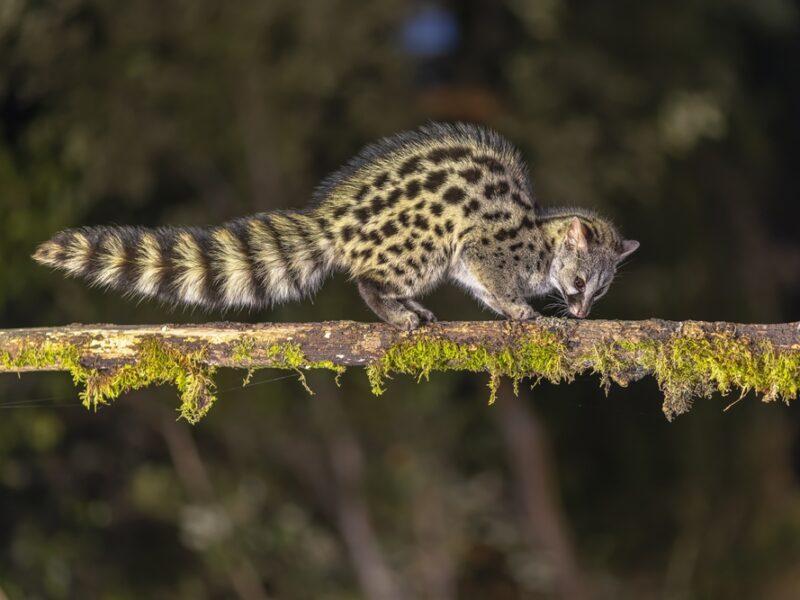
Why hunt Small Cats? An alternative Experience for South African Hunting Safaris
A small cat hunting adventure is a chance to experience an “untraditional” hunt and add a somewhat more exotic trophy to the collection. Small African cats like the ones discussed above often cannot be targeted in other game hunting destinations as the practice is illegal.
These safaris are also sometimes offered as a way for farmers and communities to control troublesome or dangerous cats that attack livestock (chickens, lambs, young goats, etc.), domestic pets, or even people. This is one of the realities of the human-animal interaction that occurs when what was a habitat is transformed into an agricultural or built-up area. In a similar vein, small cats like the serval and caracal often pose a threat to endangered species such as certain reptiles or birds.
South African hunting safaris such as these also benefit the population and conservation of small African cats and other species in the area, as hunting concessions can save land that would otherwise have been turned to mass-agricultural production or used for the logging and forestry industry. By legalizing and controlling these hunts, like with other hunts, the prospect of illegal poaching and mass culling for the alternative medicine or fur trade is reduced and efforts supporting anti-poaching activities can be bolstered by funding derived from the income brought in by these hunting adventure options.
Hunting in South Africa: How to Find and Target these Feisty Felines
Methods
Traditional South African game hunting generally employs miles of walking and tracking of spoor, but that’s not the case with these hunting adventure options.
Night hunting and the use of bait and stills
Most of the hunting for these African cats will take place at night. As these cats can be largely nocturnal, night hunting offers the best and most practical hunting method with a greater shot of securing the trophy. Due to their territorial and secretive nature, outfitters need to be sure of the target animal’s territory and routine to be able to give hunters the best advice and recommendations.
Bait and stills can be employed for both night hunts and those seeking to target their cat during the dawn or twilight hours when they are more active and on the move. Bait used for cats is typically some form of an animal that they would be hunting as prey, and this method requires a keen knowledge of the cat’s “patrol path” and territory area.
Challenges to these hunting methods include the cats’ preference for eating their own kill, meaning it’s sometimes best to wait it out over the recent kill of a cat than to try and lure it out with a chunk of meat it’s likely to skip over and walk away from. Night hunting requires good night vision aides and scopes, as well as great quietness, owing to these cats being able to hear the proverbial pin drop.
Hunting with hounds
This South African hunting safaris method of years gone by is only available for certain animals and also depends on the province. For example, Caracal may be hunted with hounds in the Eastern Cape, while Serval can be hunted with hounds across the country as long as the correct permit is applied for.
Shooting your shot
The common consensus when it comes to firepower is that any small calibre like a .223 or .22 rifle will be sufficient enough to get the job done. These cats may be smaller targets, but their skin isn’t thick or tough and does not require huge amounts of power to stop in its tracks.
Planning a Small Cat Hunting Adventure? How to get the best African cat experience
Given the nature of these game hunting safaris, the best recommendation is to use an outfitter who specializes or has a keen focus on small cats and other targets of night hunting. These outfitters will be able to provide PH’s or guides that have the necessary vital knowledge to lead you on the right trail and offer the best input when it comes to trophy quality and methods to use.
The hunter can also prepare themselves by researching and reading up on these African cats and their behaviors, as well as what target or region is best suited to their needs and desires.
Beyond the Nine Lives: Small African Cats Taxidermy
One of the best ways to remember your South African hunting safaris is to have a physical trophy to display and reminisce over. Looking at these trophies, the traditional choice is a full-body mount, either on its own or with a base or pedestal relative to the cat’s natural environment. While full-size trophies can be expensive, due to the smaller size they work out as the most practical and memorable way to immortalize your achievement.
Frequently Asked Questions
Do small African cats require a special permit?
Yes; while hunting small African cats is seen as a hunt of opportunity due to their nature, they cannot be hunted randomly while on another hunt. Small cat hunts require their own special permit or license to be considered legal and to allow the hunter to take their trophy home.
What level of skill do I need for these hunts?
Skills needed relate more to the hunting methods and understanding of the animal’s behavior. While not necessarily a beginner’s hunt, intermediate hunters and up should have no problems with these safari options.
Can I still get a decent trophy?
These trophies might not be the biggest, but does size count when the trophy isn’t as common as others? Because these cats are generally mounted in full-body styles, they offer an impressive trophy that although not the biggest, will still deliver on the wow factor.
How many small cat species are there?
Of the 40 wild cat species found around the world, 33 of them are classed as small cats. Africa is home to around 7 of them and not all species may be hunted due to their conservation status or the laws of the country.
Conclusion
Small cat hunting in South Africa is an unusual and enthralling game hunting adventure, offering unique hunting experiences for those who are interested in these smaller trophies.
Author: A. Baker
